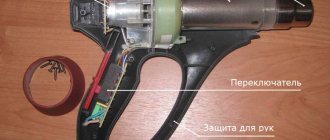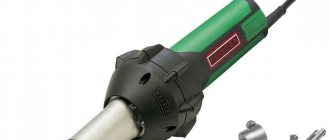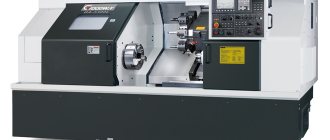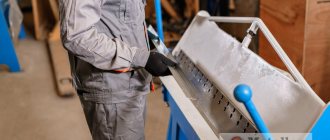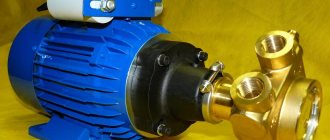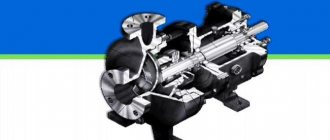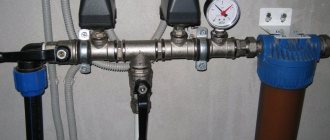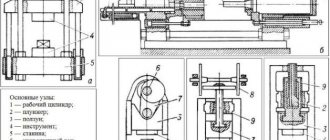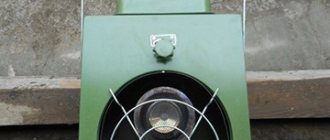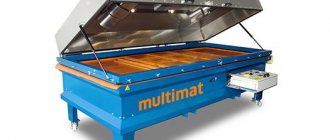Home / Accessories and parts
Back
Reading time: 1 minute
0
1158
A plastic hair dryer is a necessary type of equipment for professionals and beginners who use polymers. Of course, with the help of it, it is possible to cook plastic, plastic, polypropylene and other artificial compounds.
The welded hair dryer ensures completion of the work process in a short time. In an extremely short period of time it is possible to cope with welding plastic of any difficulty.
Even cheap varieties of this equipment will help you carry out home repair work quickly and efficiently. And industrial ones perform large volumes of work.
- basic information
- Kinds
- Welding Features
- Summary
Operating principle of a hot air gun
All devices can be divided into two groups:
- household;
- industrial.
A household hair dryer for soldering plastic is an excellent device with which you can perform many jobs: from installing linoleum to welding PVC.
Some devices are equipped with a temperature controller , which allows you to select the optimal parameters for various materials. The presence of an adjustment mechanism expands the scope of application: you can solder copper pipes with a hairdryer or carry out restoration repairs of microcircuits.
Before work, it is necessary to identify the material of the part, since only polymers from the group of thermoplastics can be heated - after heating they return to their original state without loss of performance characteristics.
The degree of temperature exposure can be adjusted by changing the distance from the nozzle to the surface of the workpiece. This requires certain skills, since if it is removed excessively, the part will not warm up to the required temperature throughout its entire depth, which will negatively affect the parameters of the seam. For example, poor-quality welding of PVC fabric leads to loss of joint tightness.
Adjusting the temperature in the Leister Electron ST hair dryer
The Leister Electron ST industrial hair dryer can be adjusted to different power levels for different attachments to achieve the required temperatures. Temperature conditions for different nozzles are presented directly on the body of the hair dryer in the form of a graph:
Temperature adjustment is carried out using a special regulator:
Design
The structure of the device is not fundamentally different from other devices for generating hot air flows. The main structural components are:
- Handle and body . The only requirement for the manufacturing material is resistance to prolonged temperature exposure. Most often, ceramics or ebonite are used as a base. If production conditions require long-term use, for example, the holder is additionally wrapped in heat-resistant fabric.
- Nozzle _ Made from steel. As practice has shown, this metal copes best with constant temperature changes. The cost of nozzles made from other alloys is much higher.
- A heating element . The thermoelement has special requirements - maintaining its shape when heated. This requirement is best met by twisted nichrome wire.
- Fan . The device has limited dimensions, so the fan must combine compact dimensions and high performance to create a stable air flow.
Functions
A technical hair dryer can be used to perform various tasks, including:
- welding (soldering) of plastic and polymers. This can be PVC film, awning fabrics, polypropylene, polyethylene;
- laying floor and roof coverings. A soldering gun is ideal for this task. Geomembrane and insulation can be used as roofing materials;
- heat shrink;
- heat treatment;
- heating and drying of elements;
- removing paint from various surfaces;
- contactless soldering of microcircuits.
Main characteristics
The quality of operation of an air soldering iron is influenced by the following parameters:
- Power . Depends on the type of products being connected. To work with electronic circuits, 300 W will be more than enough, and to weld banners with a hair dryer, a minimum of 1.5 kW is required.
- Voltage . The safest indicator - 12 V will not be enough to achieve operating parameters, so modern units operate with a voltage of 24-36 V. The resistance of the nichrome heating element should be 6 Ohms.
Types of nozzles for welding plastics
Welding attachments differ in the type of seam that will be produced during the manufacture of the product. The seam can be butt, corner (external and internal). Depending on the type of seam, the welder selects the optimal cross-section of the welding rod that he will use. The rod can be round, oval, triangular, flat. Accordingly, the nozzles for welding will be for a round rod, for a triangular rod or flat-slit. These nozzles can be considered quick welding nozzles; in addition to them, there are also adapter nozzles that are used to switch to quick welding nozzles.
Attachments for welding polypropylene sheets with extruders also differ in the type of seams and rods that will be used in the work.
We make an air soldering iron from a regular
Upgrading the device will not take much time. As a result, the master will receive a convenient heating tool that can melt any solder, including particularly hard materials.
As a basis, you can use a regular electric soldering device with a power of 40 W. To create a stable air flow, you need a miniature compressor, like an aquarium compressor. Stages of creating a hair dryer:
- First you need to remove the contact rod of the device.
- On the reverse side of the attached adapter sleeve, which will serve as the connection point for the air line.
- We drill holes in the case to bring out the power wires.
- The metal tip to which the tip was attached must be protected from heat leakage. There is no need to use expensive insulating material - foil and copper wire will handle the heat preservation function.
- We seal all holes on the body.
- In place of the rod we install a steel tube of similar dimensions. In this case, its backlash will be minimal.
This completes the assembly of a hair dryer for soldering with your own hands. Such a device is capable of heating the surface up to 300 Cº. This is enough to work with any plastic products at home. The main advantage of the device is its simplicity of design - for assembly you do not need to turn any parts on a machine or use a special tool.
Do-it-yourself operating principle
First of all, it is necessary to determine the length of the air line . If you place compresses at a large distance, the power of air flow will decrease due to constant friction from the inside of the tubes. The optimal length is 30-40 cm.
Entering the body of the soldering iron, the air passes through a heating element with increased heat capacity, and then enters the surface to be processed through a steel tube.
The disadvantages of a homemade design are the lack of a mechanism for adjusting the temperature and relatively weak air flow.
To increase air pressure, it is necessary to assemble a miniature turbine, but this will lead to an increase in the cost of the device.
Mini station with great capabilities
To assemble a more advanced device for generating hot streams, you will need a blank for a housing of sufficient size. You can use a plastic case from an old car first aid kit.
A special feature of the design is the heating element , which is installed directly into the tube. This circuit was used in old capacitors. Unlike the previous device, the compressor is placed directly in the housing, which increases its performance by reducing friction.
To regulate the temperature, use a power supply with regulation on a microcontroller. Compact dimensions allow you to use this soldering station in any conditions.
Welding equipment for welding plastics
The most popular welding equipment are hand-held welding extruders and welding guns. They are easy to use, relatively inexpensive and, due to their low weight, very convenient to use. If you have such equipment, you can manufacture products from polypropylene sheets not only in the workshop, but also on site.
The principle of operation of the equipment is to supply hot air, which heats the surfaces to be welded and the additive (welding rod or granules) to a molten state, thereby achieving a strong connection of the parts being welded.
You can learn more about the features of using welding equipment by familiarizing yourself with the technology of welding polypropylene.
Leister hand-held devices Professional welding guns and extruders Leister (Switzerland)
Weldy hand guns Construction guns and kits for welding plastics
Welding machines Leader Compact and reliable manual extruders Leader
Automatic welding machines Convenient professional automatic welding machines and testing equipment.
Welding machines Semi-automatic machines for butt welding of sheet plastics
Stitching rollers
Nozzles
How to properly assemble a homemade one?
Let's look at a diagram for assembling a reliable hairdryer for home use:
- Assembling the temperature unit. It is recommended to use a nichrome spiral with a cross section of 0.5 mm as a material for the heating element. For reliable fixation, it is wound on a cylindrical base. It is important that during the winding process the turns do not touch each other. The leads of the spirals should be secured using temperature glue.
- The temperature unit is placed in a hollow cylinder made of thermal insulating material. The outputs of the spirals are connected to the power wires. Current-carrying parts are passed through a starter and a rheostat in order to regulate the incoming voltage.
- A hair dryer is installed on one side of the tube to create air flow.
- A nozzle is installed on the reverse side, the cross-sectional size of which depends on the tasks assigned.
Making such a welding gun is not at all difficult. To expand its capabilities, we recommend developing a mechanism for replacing nozzles.
PVC Welding Machine
For welding banner fabric in large volumes, the Mixt company offers specialized welding equipment, specially adapted for welding PVC. The most popular model on the Russian market is the Miller WeldmasterT-300 Extreme.
T-300 Extreme is a new development from Miller Weldmaster. Designed for welding PVC products. T-300 Extreme combines unique parameters: ergonomics, easy interface, speed, accuracy and productivity. T-300 is used in various fields:
- Production of advertising banners and banners
- Awnings for cars, tents, etc.
- Inflatable products for children (circles, inflatable attractions, etc.)
- Inflatable boats and inflatable life rafts (PSN)
Making a machine for soldering microcircuits
The components of this device do not differ from the devices that were discussed above. Particular attention should be paid to the housing , since it will experience constant temperature loads. The difficulty is that the cost of thermal insulation materials is quite high, so it is best to use an old hair dryer as a base.
The nozzle attachment point is the most critical area that requires careful insulation. Otherwise, the heat will be transferred to other areas of the hair dryer, which will complicate the soldering process.
The temperature regulator is best placed on the handle . This will allow you to change the basic parameter without being distracted from your work. We recommend using elements from old household appliances as a switch.
Step-by-step instruction
- Select a rod that matches the composition of the material. If this is not observed, then heating will occur at different times and the seam will be of poor quality.
- Select temperature mode.
- You need to clean the edges of the elements with sandpaper, a sanding machine or a file.
- Bring the rod of a welding gun with a sharp end to the finished cleaned part and begin to connect.
- While melting the rod, carefully push through the polypropylene by pressing on it. At the same time, smoothly move the solder, drowning the rod in the crack. This should be done throughout the entire seam.
- Residual particles of the rod must be removed. Use a heat gun to heat the excess and gently pull it to your side until it comes off the surface. Do this carefully as you risk tearing off the still hot part of the polypropylene.
- Once the joint has cooled completely, you can begin sanding it.
